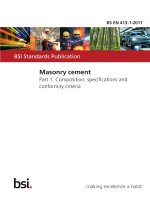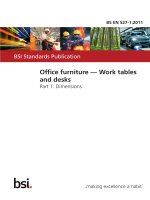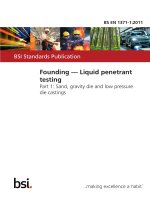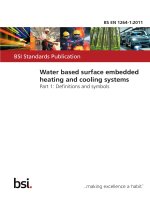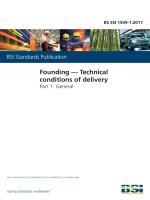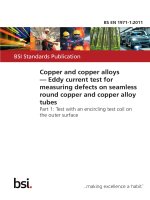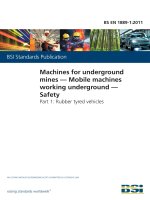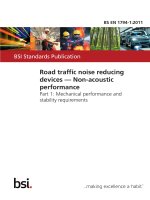Bsi bs en 61439 1 2011
Bạn đang xem bản rút gọn của tài liệu. Xem và tải ngay bản đầy đủ của tài liệu tại đây (2.12 MB, 148 trang )
BS EN 61439-1:2011
BSI Standards Publication
Low-voltage switchgear and
controlgear assemblies
Part 1: General rules
BRITISH STANDARD
BS EN 61439-1:2011
National foreword
This British Standard is the UK implementation of EN 61439-1:2011. It is
identical to IEC 61439-1:2011. It supersedes BS EN 61439-1:2009, which will
be withdrawn on 23 September 2014.
The UK participation in its preparation was entrusted by Technical Committee
PEL/17, Switchgear, controlgear, and HV-LV co-ordination, to Subcommittee
PEL/17/3, Low voltage switchgear and controlgear assemblies.
A list of organizations represented on this committee can be obtained on
request to its secretary.
This publication does not purport to include all the necessary provisions of a
contract. Users are responsible for its correct application.
© BSI 2011
ISBN 978 0 580 67925 4
ICS 29.130.20
Compliance with a British Standard cannot confer immunity from
legal obligations.
This British Standard was published under the authority of the Standards
Policy and Strategy Committee on 30 November 2011.
Amendments issued since publication
Amd. No.
Date
Text affected
BS EN 61439-1:2011
EUROPEAN STANDARD
EN 61439-1
NORME EUROPÉENNE
EUROPÄISCHE NORM
October 2011
ICS 29.130.20
Supersedes EN 61439-1:2009
English version
Low-voltage switchgear and controlgear assemblies Part 1: General rules
(IEC 61439-1:2011)
Ensembles d'appareillage
à basse tension Partie 1: Règles générales
(CEI 61439-1:2011)
NiederspannungsSchaltgerätekombinationen Teil 1: Allgemeine Festlegungen
(IEC 61439-1:2011)
This European Standard was approved by CENELEC on 2011-09-23. CENELEC members are bound to comply
with the CEN/CENELEC Internal Regulations which stipulate the conditions for giving this European Standard
the status of a national standard without any alteration.
Up-to-date lists and bibliographical references concerning such national standards may be obtained on
application to the CEN-CENELEC Management Centre or to any CENELEC member.
This European Standard exists in three official versions (English, French, German). A version in any other
language made by translation under the responsibility of a CENELEC member into its own language and notified
to the CEN-CENELEC Management Centre has the same status as the official versions.
CENELEC members are the national electrotechnical committees of Austria, Belgium, Bulgaria, Croatia, Cyprus,
the Czech Republic, Denmark, Estonia, Finland, France, Germany, Greece, Hungary, Iceland, Ireland, Italy,
Latvia, Lithuania, Luxembourg, Malta, the Netherlands, Norway, Poland, Portugal, Romania, Slovakia, Slovenia,
Spain, Sweden, Switzerland and the United Kingdom.
CENELEC
European Committee for Electrotechnical Standardization
Comité Européen de Normalisation Electrotechnique
Europäisches Komitee für Elektrotechnische Normung
Management Centre: Avenue Marnix 17, B - 1000 Brussels
© 2011 CENELEC -
All rights of exploitation in any form and by any means reserved worldwide for CENELEC members.
Ref. No. EN 61439-1:2011 E
BS EN 61439-1:2011
EN 61439-1:2011
-2-
Foreword
The text of document 17D/441/FDIS, future edition 2 of IEC 61439-1, prepared by SC 17D, "Low-voltage
switchgear and controlgear assemblies", of IEC TC 17, "Switchgear and controlgear" was submitted to
the IEC-CENELEC parallel vote and approved by CENELEC as EN 61439-1:2011.
The following dates are fixed:
•
•
latest date by which the document has
to be implemented at national level by
publication of an identical national
standard or by endorsement
latest date by which the national
standards conflicting with the
document have to be withdrawn
(dop)
2012-06-23
(dow)
2014-09-23
This document supersedes EN 61439-1:2009.
EN 61439-1:2011 includes the following significant technical changes with respect to EN 61439-1:2009:
— revision of service conditions in Clause 7;
— numerous changes regarding verification methods in Clause 10;
— modification of routine verification in respect of clearances and creepage distances (see 11.3);
— adaption of the tables in Annex C and Annex D to the revised requirements and verification methods;
— shifting of tables from Annex H to new Annex N;
— new Annex O with guidance on temperature rise verification;
— new Annex P with a verification method for short-circuit withstand strength (integration of the content
of IEC/TR 61117);
— update of normative references;
— general editorial review.
NOTE It should be noted that when a dated reference to EN 60439-1 is made in another Part of the EN 60439 series of assembly
standards not yet transferred into the new EN 61439 series, the superseded EN 60439-1 still applies (see also the Introduction
below).
Attention is drawn to the possibility that some of the elements of this document may be the subject of
patent rights. CENELEC [and/or CEN] shall not be held responsible for identifying any or all such patent
rights.
This document has been prepared under a mandate given to CENELEC by the European Commission
and the European Free Trade Association, and supports essential requirements of EU Directive(s).
For the relationship with EU Directive see informative Annex ZZ, which is an integral part of this
document.
-3-
BS EN 61439-1:2011
EN 61439-1:2011
Endorsement notice
The text of the International Standard IEC 61439-1:2011 was approved by CENELEC as a European
Standard without any modification.
In the official version, for Bibliography, the following notes have to be added for the standards indicated:
IEC 60038
NOTE Harmonized as EN 60038.
IEC 60079 series
NOTE Harmonized in EN 60079 series.
IEC 60112:2003
NOTE Harmonized as EN 60112:2003 (not modified).
IEC 60204 series
NOTE Harmonized in EN 60204 series.
IEC 60204-1
NOTE Harmonized as EN 60204-1.
IEC 60228:2004
NOTE Harmonized as EN 60228:2005 (not modified).
IEC 60947 series
NOTE Harmonized in EN 60947 series.
IEC 61000-3-2:2005
NOTE Harmonized as EN 61000-3-2:2006 (not modified).
IEC 61000-3-3
NOTE Harmonized as EN 61000-3-3.
IEC 61000-3-11
NOTE Harmonized as EN 61000-3-11.
IEC 61000-3-12
NOTE Harmonized as EN 61000-3-12.
IEC 61000-6-1
NOTE Harmonized as EN 61000-6-1.
IEC 61000-6-2
NOTE Harmonized as EN 61000-6-2.
IEC 61000-6-3
NOTE Harmonized as EN 61000-6-3.
IEC 61082 series
NOTE Harmonized in EN 61082 series.
IEC 61140:2001
NOTE Harmonized as EN 61140:2002 (not modified).
IEC 61241 series
NOTE Harmonized in EN 61241 series.
BS EN 61439-1:2011
EN 61439-1:2011
-4-
Annex ZA
(normative)
Normative references to international publications
with their corresponding European publications
The following referenced documents are indispensable for the application of this document. For dated
references, only the edition cited applies. For undated references, the latest edition of the referenced
document (including any amendments) applies.
NOTE When an international publication has been modified by common modifications, indicated by (mod), the relevant EN/HD
applies.
Publication
Year
Title
EN/HD
Year
IEC 60068-2-2
2007
Environmental testing Part 2-2: Tests - Test B: Dry heat
EN 60068-2-2
2007
IEC 60068-2-11
1981
Environmental testing Part 2: Tests - Test Ka: Salt mist
EN 60068-2-11
1999
IEC 60068-2-30
2005
Environmental testing EN 60068-2-30
Part 2-30: Tests - Test Db: Damp heat, cyclic
(12 h + 12 h cycle)
2005
IEC 60073
2002
Basic and safety principles for man-machine EN 60073
interface, marking and identification - Coding
principles for indicators and actuators
2002
IEC 60085
2007
Electrical insulation - Thermal evaluation and EN 60085
designation
2008
IEC 60216
Series Electrical insulating materials - Properties of
thermal endurance
EN 60216
1)
HD 21.3 S3
+ A1
+ A2
IEC 60227-3 (mod) 1993
Polyvinyl chloride insulated cables of rated
voltages up to and including 450/750 V Part 3: Non-sheathed cables for fixed wiring
IEC 60245-3
Rubber insulated cables - Rated voltages up to and including 450/750 V Part 3: Heat resistant silicone insulated cables
1994
IEC 60245-4 (mod) 1994
Series
1995
1999
2008
-
2)
Cables of rated voltages up to and including HD 22.4 S3
450/750 V and having cross-linked insulation - + A1
Part 4: Cords and flexible cables
+ A2
1995
1999
2002
IEC 60364
Series Low-voltage electrical installations
HD 60364
Series
IEC 60364-4-41
(mod)
2005
Low-voltage electrical installations Part 4-41: Protection for safety - Protection
against electric shock
HD 60364-4-41
+ corr. July
2007
2007
IEC 60364-4-44
(mod)
2007
Low voltage electrical installations Part 4-44: Protection for safety - Protection
against voltage disturbances and
electromagnetic disturbances
HD 60364-4-444
+ corr. July
2010
2010
IEC 60364-5-52
(mod)
2009
HD 60364-5-52
Low-voltage electrical installations Part 5-52: Selection and erection of electrical
equipment - Wiring systems
2011
IEC 60364-5-53
2001
Electrical installations of buildings Part 5-53: Selection and erection of electrical
equipment - Isolation, switching and control
-
1)
HD 21.3 S3 is superseded by EN 50525-2-31:2011.
2)
HD 22.4 S3 is superseded by HD 22.4 S4:2004.
BS EN 61439-1:2011
EN 61439-1:2011
-5Publication
Year
Title
IEC 60364-5-54
2011
Low-voltage electrical installations HD 60364-5-54
Part 5-54: Selection and erection of electrical
equipment - Earthing arrangements and
protective conductors
IEC 60439
Series Low-voltage switchgear and controlgear
assemblies
IEC 60445
2010
Basic and safety principles for man-machine EN 60445
interface, marking and identification Identification of equipment terminals,
conductor terminations and conductors
2010
IEC 60447
2004
Basic and safety principles for man-machine EN 60447
interface, marking and identification Actuating principles
2004
IEC 60529
1989
Degrees of protection provided by enclosures EN 60529
(IP Code)
+ corr. May
1991
1993
IEC 60664-1
2007
Insulation coordination for equipment within
low-voltage systems Part 1: Principles, requirements and tests
2007
IEC 60695-2-10
2000
Fire hazard testing EN 60695-2-10
Part 2-10: Glowing/hot-wire based test
methods - Glow-wire apparatus and common
test procedure
2001
IEC 60695-2-11
2000
EN 60695-2-11
Fire hazard testing Part 2-11: Glowing/hot-wire based test
methods - Glow-wire flammability test method
for end-products
2001
IEC 60695-11-5
2004
Fire hazard testing Part 11-5: Test flames - Needle-flame test
method - Apparatus, confirmatory test
arrangement and guidance
2005
IEC 60865-1
1993
Short-circuit currents - Calculation of effects - EN 60865-1
Part 1: Definitions and calculation methods
IEC/TR3 60890
1987
A method of temperature-rise assessment by CLC/TR 60890
extrapolation for partially type-tested
assemblies (PTTA) of low-voltage switchgear
and controlgear
2002
IEC 60947-1
2007
Low-voltage switchgear and controlgear Part 1: General rules
2007
IEC 61000-4-2
2008
EN 61000-4-2
Electromagnetic compatibility (EMC) Part 4-2: Testing and measurement
techniques - Electrostatic discharge immunity
test
2009
IEC 61000-4-3
2006
Electromagnetic compatibility (EMC) Part 4-3: Testing and measurement
techniques - Radiated, radio-frequency,
electromagnetic field immunity test
EN 61000-4-3
2006
IEC 61000-4-4
2004
Electromagnetic compatibility (EMC) Part 4-4: Testing and measurement
techniques - Electrical fast transient/burst
immunity test
EN 61000-4-4
2004
3)
EN/HD
Year
EN 60439
Series
EN 60664-1
EN 60695-11-5
1993
3)
CLC/TR 60890 includes A1:1995 to IEC/TR3 60890 + corr. March 1988.
EN 60947-1
2011
BS EN 61439-1:2011
EN 61439-1:2011
-6-
Publication
Year
Title
EN/HD
Year
IEC 61000-4-5
2005
Electromagnetic compatibility (EMC) Part 4-5: Testing and measurement
techniques - Surge immunity test
EN 61000-4-5
2006
IEC 61000-4-6
2008
Electromagnetic compatibility (EMC) Part 4-6: Testing and measurement
techniques - Immunity to conducted
disturbances, induced by radio-frequency
fields
EN 61000-4-6
2009
IEC 61000-4-8
2009
EN 61000-4-8
Electromagnetic compatibility (EMC) Part 4-8: Testing and measurement
techniques - Power frequency magnetic field
immunity test
2010
IEC 61000-4-11
2004
Electromagnetic compatibility (EMC) EN 61000-4-11
Part 4-11: Testing and measurement
techniques - Voltage dips, short interruptions
and voltage variations immunity tests
2004
IEC 61000-4-13
2002
EN 61000-4-13
Electromagnetic compatibility (EMC) Part 4-13: Testing and measurement
techniques - Harmonics and interharmonics
including mains signalling at a.c. power port,
low frequency immunity tests
2002
IEC 61000-6-4
2006
Electromagnetic compatibility (EMC) Part 6-4: Generic standards - Emission
standard for industrial environments
EN 61000-6-4
2007
IEC 61082-1
-
Preparation of documents used in
electrotechnology Part 1: Rules
EN 61082-1
-
IEC 61180
Series High-voltage test techniques for low-voltage
equipment
EN 61180
Series
IEC/TS 61201
2007
-
-
IEC 61439
Series Low-voltage switchgear and controlgear
assemblies
EN 61439
Series
IEC 62208
-
Empty enclosures for low-voltage switchgear EN 62208
and controlgear assemblies - General
requirements
-
IEC 62262
2002
Degrees of protection provided by enclosures EN 62262
for electrical equipment against external
mechanical impacts (IK code)
2002
IEC 81346-1
-
Industrial systems, installations and
equipment and industrial products Structuring principles and reference
designations Part 1: Basic rules
EN 81346-1
-
IEC 81346-2
-
EN 81346-2
Industrial systems, installations and
equipment and industrial products Structuring principles and reference
designations Part 2: Classification of objects and codes for
classes
-
CISPR 11 (mod)
2009
Industrial, scientific and medical equipment - EN 55011
Radio-frequency disturbance characteristics Limits and methods of measurement
2009
Use of conventional touch voltage limits Application guide
BS EN 61439-1:2011
EN 61439-1:2011
-7Publication
Year
Title
EN/HD
Year
CISPR 22
-
Information technology equipment - Radio
disturbance characteristics - Limits and
methods of measurement
EN 55022
-
ISO 178
2001
Plastics - Determination of flexural properties EN ISO 178
ISO 179
Series Plastics - Determination of Charpy impact
properties
EN ISO 179
Series
ISO 2409
2007
Paints and varnishes - Cross-cut test
EN ISO 2409
2007
ISO 4628-3
2003
EN ISO 4628-3
Paints and varnishes - Evaluation of
degradation of coatings - Designation of
quantity and size of defects, and of intensity of
uniform changes in appearance Part 3: Assessment of degree of rusting
2003
ISO 4892-2
2006
Plastics - Methods of exposure to laboratory
light sources Part 2: Xenon-arc lamps
EN ISO 4892-2
2006
2003
BS EN 61439-1:2011
EN 61439-1:2011
-8-
Annex ZZ
(informative)
Coverage of Essential Requirements of EC Directive 2004/108/EC
This European Standard has been prepared under a mandate given to CENELEC by the European
Commission and the European Free Trade Association and within its scope the standard covers all
relevant essential requirements as given in Article 1 of Annex I of the EC Directive 2004/108/EC.
This Part 1 of the EN 61439 series alone does not give presumption of conformity with the essential
requirements of the EMC Directive without another relevant part of the series (e.g. EN 61439-2 for power
switchgear and controlgear assemblies). These product parts call up the applicable EMC requirements of
EN 61439-1 for assemblies within their specific scope.
WARNING: Other requirements and other EC Directives may be applicable to the products falling within
the scope of this standard.
–2–
BS EN 61439-1:2011
61439-1 © IEC:2011
CONTENTS
INTRODUCTION ................................................................................................................... 11
1
Scope ............................................................................................................................. 12
2
Normative references ..................................................................................................... 12
3
Terms and definitions ..................................................................................................... 15
4
3.1 General terms ....................................................................................................... 15
3.2 Constructional units of ASSEMBLIES ........................................................................ 17
3.3 External design of ASSEMBLIES ............................................................................... 18
3.4 Structural parts of ASSEMBLIES ............................................................................... 18
3.5 Conditions of installation of ASSEMBLIES ................................................................. 20
3.6 Insulation characteristics ....................................................................................... 20
3.7 Protection against electric shock ........................................................................... 23
3.8 Characteristics ...................................................................................................... 25
3.9 Verification ............................................................................................................ 27
3.10 Manufacturer/user ................................................................................................. 28
Symbols and abbreviations ............................................................................................. 28
5
Interface characteristics ................................................................................................. 29
5.1
5.2
6
7
General ................................................................................................................. 29
Voltage ratings ...................................................................................................... 29
5.2.1 Rated voltage (U n ) (of the ASSEMBLY ) ........................................................ 29
5.2.2 Rated operational voltage (U e ) (of a circuit of an ASSEMBLY ) ...................... 29
5.2.3 Rated insulation voltage (U i ) (of a circuit of an ASSEMBLY ) ......................... 29
5.2.4 Rated impulse withstand voltage (U imp ) (of the ASSEMBLY ) ........................ 29
5.3 Current ratings ...................................................................................................... 30
5.3.1 Rated current of the ASSEMBLY (I nA ) .......................................................... 30
5.3.2 Rated current of a circuit (I nc ) ................................................................... 30
5.3.3 Rated peak withstand current (I pk ) ............................................................ 30
5.3.4 Rated short-time withstand current (I cw ) (of a circuit of an ASSEMBLY ) ....... 30
5.3.5 Rated conditional short-circuit current of an ASSEMBLY (I cc ) ....................... 30
5.4 Rated diversity factor (RDF) .................................................................................. 31
5.5 Rated frequency (f n ) .............................................................................................. 31
5.6 Other characteristics ............................................................................................. 31
Information ..................................................................................................................... 32
6.1
6.2
ASSEMBLY
designation marking .............................................................................. 32
Documentation ...................................................................................................... 32
6.2.1 Information relating to the ASSEMBLY .......................................................... 32
6.2.2 Instructions for handling, installation, operation and maintenance ............. 32
6.3 Device and/or component identification ................................................................. 33
Service conditions .......................................................................................................... 33
7.1
Normal service conditions ..................................................................................... 33
7.1.1 Ambient air temperature ............................................................................ 33
7.1.2 Humidity conditions ................................................................................... 33
7.1.3 Pollution degree ........................................................................................ 33
7.1.4 Altitude ...................................................................................................... 34
Special service conditions ..................................................................................... 34
Conditions during transport, storage and installation ............................................. 35
7.2
7.3
BS EN 61439-1:2011
61439-1 © IEC:2011
8
–3–
Constructional requirements ........................................................................................... 35
8.1
9
Strength of materials and parts .............................................................................. 35
8.1.1 General ..................................................................................................... 35
8.1.2 Protection against corrosion ...................................................................... 35
8.1.3 Properties of insulating materials ............................................................... 35
8.1.4 Resistance to ultra-violet radiation ............................................................. 36
8.1.5 Mechanical strength .................................................................................. 36
8.1.6 Lifting provision ......................................................................................... 36
8.2 Degree of protection provided by an ASSEMBLY enclosure ...................................... 36
8.2.1 Protection against mechanical impact ........................................................ 36
8.2.2 Protection against contact with live parts, ingress of solid foreign
bodies and water ....................................................................................... 36
8.2.3 ASSEMBLY with removable parts .............................................................. 37
8.3 Clearances and creepage distances ...................................................................... 37
8.3.1 General ..................................................................................................... 37
8.3.2 Clearances ................................................................................................ 38
8.3.3 Creepage distances ................................................................................... 38
8.4 Protection against electric shock ........................................................................... 39
8.4.1 General ..................................................................................................... 39
8.4.2 Basic protection ......................................................................................... 39
8.4.3 Fault protection ......................................................................................... 40
8.4.4 Protection by total insulation ...................................................................... 42
8.4.5 Limitation of steady-state touch current and charge ................................... 43
8.4.6 Operating and servicing conditions ............................................................ 43
8.5 Incorporation of switching devices and components .............................................. 45
8.5.1 Fixed parts ................................................................................................ 45
8.5.2 Removable parts ....................................................................................... 45
8.5.3 Selection of switching devices and components ......................................... 46
8.5.4 Installation of switching devices and components ...................................... 46
8.5.5 Accessibility .............................................................................................. 46
8.5.6 Barriers ..................................................................................................... 47
8.5.7 Direction of operation and indication of switching positions........................ 47
8.5.8 Indicator lights and push-buttons ............................................................... 47
8.6 Internal electrical circuits and connections ............................................................ 47
8.6.1 Main circuits .............................................................................................. 47
8.6.2 Auxiliary circuits ........................................................................................ 48
8.6.3 Bare and insulated conductors .................................................................. 48
8.6.4 Selection and installation of non-protected live conductors to reduce
the possibility of short-circuits ................................................................... 49
8.6.5 Identification of the conductors of main and auxiliary circuits ..................... 49
8.6.6 Identification of the protective conductor (PE, PEN) and of the
neutral conductor (N) of the main circuits .................................................. 49
8.7 Cooling .................................................................................................................. 49
8.8 Terminals for external conductors .......................................................................... 49
Performance requirements ............................................................................................. 51
9.1
Dielectric properties .............................................................................................. 51
9.1.1 General ..................................................................................................... 51
9.1.2 Power-frequency withstand voltage ........................................................... 51
9.1.3 Impulse withstand voltage ......................................................................... 51
–4–
BS EN 61439-1:2011
61439-1 © IEC:2011
9.1.4 Protection of surge protective devices ....................................................... 51
9.2 Temperature rise limits .......................................................................................... 52
9.3 Short-circuit protection and short-circuit withstand strength ................................... 52
9.3.1 General ..................................................................................................... 52
9.3.2 Information concerning short-circuit withstand strength ............................. 52
9.3.3 Relationship between peak current and short-time current ......................... 53
9.3.4 Co-ordination of protective devices ............................................................ 53
9.4 Electromagnetic compatibility (EMC) ..................................................................... 53
10 Design verification .......................................................................................................... 54
10.1 General ................................................................................................................. 54
10.2 Strength of materials and parts .............................................................................. 55
10.2.1 General ..................................................................................................... 55
10.2.2 Resistance to corrosion ............................................................................. 55
10.2.3 Properties of insulating materials ............................................................... 56
10.2.4 Resistance to ultra-violet (UV) radiation..................................................... 58
10.2.5 Lifting ........................................................................................................ 58
10.2.6 Mechanical impact ..................................................................................... 59
10.2.7 Marking ..................................................................................................... 59
10.3 Degree of protection of ASSEMBLIES ....................................................................... 59
10.4 Clearances and creepage distances ...................................................................... 59
10.5 Protection against electric shock and integrity of protective circuits ....................... 60
10.5.1 Effectiveness of the protective circuit......................................................... 60
10.5.2 Effective earth continuity between the exposed conductive parts of
the ASSEMBLY and the protective circuit ...................................................... 60
10.5.3 Short-circuit withstand strength of the protective circuit ............................. 60
10.6 Incorporation of switching devices and components .............................................. 61
10.6.1 General ..................................................................................................... 61
10.6.2 Electromagnetic compatibility .................................................................... 61
10.7 Internal electrical circuits and connections ............................................................ 61
10.8 Terminals for external conductors .......................................................................... 61
10.9 Dielectric properties .............................................................................................. 61
10.9.1 General ..................................................................................................... 61
10.9.2 Power-frequency withstand voltage ........................................................... 61
10.9.3 Impulse withstand voltage ......................................................................... 62
10.9.4 Testing of enclosures made of insulating material ...................................... 64
10.9.5 External operating handles of insulating material ....................................... 64
10.10 Verification of temperature rise .............................................................................. 64
10.10.1 General ..................................................................................................... 64
10.10.2 Verification by testing ................................................................................ 64
10.10.3 Derivation of ratings for similar variants ..................................................... 70
10.10.4 Verification assessment ............................................................................. 71
10.11 Short-circuit withstand strength ............................................................................. 74
10.11.1 General ..................................................................................................... 74
10.11.2 Circuits of ASSEMBLIES which are exempted from the verification of
the short-circuit withstand strength ............................................................ 74
10.11.3 Verification by comparison with a reference design – Utilising a
check list ................................................................................................... 75
10.11.4 Verification by comparison with a reference design – Utilising
calculation ................................................................................................. 75
10.11.5 Verification by test ..................................................................................... 75
BS EN 61439-1:2011
61439-1 © IEC:2011
–5–
10.12 Electromagnetic compatibility (EMC) ..................................................................... 80
10.13 Mechanical operation ............................................................................................ 80
11 Routine verification ......................................................................................................... 80
11.1 General ................................................................................................................. 80
11.2 Degree of protection of enclosures ........................................................................ 81
11.3 Clearances and creepage distances ...................................................................... 81
11.4 Protection against electric shock and integrity of protective circuits ....................... 81
11.5 Incorporation of built-in components ...................................................................... 81
11.6 Internal electrical circuits and connections ............................................................ 81
11.7 Terminals for external conductors .......................................................................... 81
11.8 Mechanical operation ............................................................................................ 82
11.9 Dielectric properties .............................................................................................. 82
11.10 Wiring, operational performance and function ........................................................ 82
Annex A (normative) Minimum and maximum cross-section of copper conductors
suitable for connection to terminals for external conductors (see 8.8) ................................... 90
Annex B (normative) Method of calculating the cross-sectional area of protective
conductors with regard to thermal stresses due to currents of short duration ........................ 91
Annex C (informative) User information template ................................................................. 92
Annex D (informative) Design verification ............................................................................ 96
Annex E (informative) Rated diversity factor ........................................................................ 97
Annex F (normative) Measurement of clearances and creepage distances ........................ 106
Annex G (normative) Correlation between the nominal voltage of the supply system
and the rated impulse withstand voltage of the equipment .................................................. 111
Annex H (informative) Operating current and power loss of copper conductors .................. 113
Annex I (Void) ..................................................................................................................... 115
Annex J (normative) Electromagnetic compatibility (EMC).................................................. 116
Annex K (normative) Protection by electrical separation..................................................... 123
Annex L (informative) Clearances and creepage distances for North American region ....... 126
Annex M (informative) North American temperature rise limits ........................................... 127
Annex N (normative) Operating current and power loss of bare copper bars ...................... 128
Annex O (informative) Guidance on temperature rise verification ....................................... 130
Annex P (normative) Verification of the short-circuit withstand strength of busbar
structures by comparison with a tested reference design by calculation .............................. 135
Bibliography ........................................................................................................................ 139
Figure E.1 – Typical ASSEMBLY .............................................................................................. 98
Figure E.2 – Example 1: Table E.1 – Functional unit loading for an ASSEMBLY with a
rated diversity factor of 0,8 ................................................................................................. 100
Figure E.3 – Example 2: Table E.1 – Functional unit loading for an ASSEMBLY with a
rated diversity factor of 0,8 ................................................................................................. 101
Figure E.4 – Example 3: Table E.1 – Functional unit loading for an ASSEMBLY with a
rated diversity factor of 0,8 ................................................................................................. 102
Figure E.5 – Example 4: Table E.1 – Functional unit loading for an ASSEMBLY with a
rated diversity factor of 0,8 ................................................................................................. 103
Figure E.6 – Example of average heating effect calculation ................................................ 104
Figure E.7 – Example graph for the relation between the equivalent RDF and the
parameters at intermittent duty at t 1 = 0,5 s, I 1 = 7*I 2 at different cycle times .................... 105
–6–
BS EN 61439-1:2011
61439-1 © IEC:2011
Figure E.8 – Example graph for the relation between the equivalent RDF and the
parameters at intermittent duty at I 1 = I 2 (no starting overcurrent) ...................................... 105
Figure F.1 – Measurement of ribs ....................................................................................... 110
Figure J.1 – Examples of ports ........................................................................................... 116
Figure O.1 – Temperature rise verification methods ............................................................ 134
Figure P.1 – Tested busbar structure (TS) .......................................................................... 135
Figure P.2 – Non tested busbar structure (NTS) .................................................................. 136
Figure P.3 – Angular busbar configuration with supports at the corners .............................. 138
Table 1 – Minimum clearances in air a (8.3.2) ....................................................................... 82
Table 2 – Minimum creepage distances (8.3.3) ..................................................................... 83
Table 3 – Cross-sectional area of a copper protective conductor (8.4.3.2.2) ......................... 83
Table 4 – Conductor selection and installation requirements (8.6.4) ...................................... 84
Table 5 – Minimum terminal capacity for copper protective conductors (PE, PEN) (8.8) ........ 84
Table 6 – Temperature-rise limits (9.2) ................................................................................. 85
Table 7 – Values for the factor n a (9.3.3) ............................................................................. 86
Table 8 – Power-frequency withstand voltage for main circuits (10.9.2) ................................ 86
Table 9 – Power-frequency withstand voltage for auxiliary and control circuits (10.9.2) ......... 86
Table 10 – Impulse withstand test voltages (10.9.3) .............................................................. 87
Table 11 – Copper test conductors for rated currents up to 400 A inclusive
(10.10.2.3.2) ......................................................................................................................... 87
Table 12 – Copper test conductors for rated currents from 400 A to 4 000 A
(10.10.2.3.2) ......................................................................................................................... 88
Table 13 – Short-circuit verification by comparison with a reference design: check list
(10.5.3.3, 10.11.3 and 10.11.4) ............................................................................................. 88
Table 14 – Relationship between prospective fault current and diameter of copper wire ...... 89
Table A.1 – Cross-section of copper conductors suitable for connection to terminals
for external conductors ......................................................................................................... 90
Table B.1 – Values of k for insulated protective conductors not incorporated in cables,
or bare protective conductors in contact with cable covering ................................................. 91
Table C.1 – Template ........................................................................................................... 92
Table D.1 – List of design verifications to be performed ........................................................ 96
Table E.1 – Examples of loading for an ASSEMBLY with a rated diversity factor of 0,8 ............ 99
Table E.2 – Example of loading of a group of circuits (Section B – Figure E.1) with a
rated diversity factor of 0,9 ................................................................................................. 104
Table E.3 – Example of loading of a group of circuits (Sub-distribution board – Figure
E.1) with a rated diversity factor of 0,9 ................................................................................ 104
Table F.1 – Minimum width of grooves ................................................................................ 106
Table G.1 – Correspondence between the nominal voltage of the supply system and
the equipment rated impulse withstand voltage ................................................................... 112
Table H.1 – Operating current and power loss of single-core copper cables with a
permissible conductor temperature of 70 °C (ambient temperature inside the
ASSEMBLY : 55 °C) ................................................................................................................ 113
Table H.2 – Reduction factor k 1 for cables with a permissible conductor temperature
of 70 °C (extract from IEC 60364-5-52:2009, Table B.52.14)............................................... 114
Table J.1 – Tests for EMC immunity for environment A (see J.10.12.1) ............................... 120
Table J.2 – Tests for EMC immunity for environment B (see J.10.12.1) ............................... 121
BS EN 61439-1:2011
61439-1 © IEC:2011
–7–
Table J.3 – Acceptance criteria when electromagnetic disturbances are present ................. 122
Table K.1 – Maximum disconnecting times for TN systems ................................................. 125
Table L.1 – Minimum clearances in air ................................................................................ 126
Table L.2 – Minimum creepage distances ........................................................................... 126
Table M.1 – North American temperature rise limits ............................................................ 127
Table N.1 – Operating current and power loss of bare copper bars with rectangular
cross-section, run horizontally and arranged with their largest face vertical, frequency
50 Hz to 60 Hz (ambient temperature inside the ASSEMBLY : 55 °C, temperature of the
conductor 70 °C) ................................................................................................................. 128
Table N.2 – Factor k 4 for different temperatures of the air inside the ASSEMBLY and/or
for the conductors ............................................................................................................... 129
BS EN 61439-1:2011
61439-1 © IEC:2011
– 11 –
INTRODUCTION
The purpose of this standard is to harmonize as far as practicable all rules and requirements
of a general nature applicable to low-voltage switchgear and controlgear assemblies
(ASSEMBLIES) in order to obtain uniformity of requirements and verification for ASSEMBLIES and
to avoid the need for verification to other standards. All those requirements for the various
ASSEMBLIES standards which can be considered as general have therefore been gathered in
this basic standard together with specific subjects of wide interest and application, e.g.
temperature rise, dielectric properties, etc.
For each type of low-voltage switchgear and controlgear assembly only two main standards
are necessary to determine all requirements and the corresponding methods of verification:
–
this basic standard referred to as “Part 1” in the specific standards covering the various
types of low-voltage switchgear and controlgear assemblies ;
–
the specific ASSEMBLY standard hereinafter also referred to as the relevant ASSEMBLY
standard.
For a general rule to apply to a specific ASSEMBLY standard, it should be explicitly referred to
by quoting the relevant clause or sub-clause number of this standard followed by “Part 1” e.g.
“9.1.3 of Part 1”.
A specific ASSEMBLY standard may not require and hence need not call up a general rule
where it is not applicable, or it may add requirements if the general rule is deemed inadequate
in the particular case but it may not deviate from it unless there is substantial technical
justification detailed in the specific ASSEMBLY standard.
Where in this standard a cross-reference is made to another clause, the reference is to be
taken to apply to that clause as amended by the specific ASSEMBLY standard, where
applicable.
Requirements in this standard that are subject to agreement between the ASSEMBLY
manufacturer and the user are summarised in Annex C (informative). This schedule also
facilitates the supply of information on basic conditions and additional user specifications to
enable proper design, application and utilization of the ASSEMBLY .
For the new re-structured IEC 61439 series, the following parts are envisaged:
a) IEC 61439-1: General rules
b) IEC 61439-2: Power switchgear and controlgear ASSEMBLIES ( PSC - ASSEMBLIES )
c) IEC 61439-3: Distribution boards (to supersede IEC 60439-3)
d) IEC 61439-4: ASSEMBLIES for construction sites (to supersede IEC 60439-4)
e) IEC 61439-5: ASSEMBLIES for power distribution (to supersede IEC 60439-5)
f)
IEC 61439-6: Busbar trunking systems (to supersede IEC 60439-2)
g) IEC/TR 61439-0: Guidance to specifying ASSEMBLIES .
This list is not exhaustive; additional Parts may be developed as the need arises.
BS EN 61439-1:2011
– 12 –
61439-1 © IEC:2011
LOW-VOLTAGE SWITCHGEAR
AND CONTROLGEAR ASSEMBLIES –
Part 1: General rules
1
Scope
NOTE 1 Throughout this standard, the term ASSEMBLY (see 3.1.1) is used for a low-voltage switchgear and
controlgear assembly.
This part of the IEC 61439 series lays down the definitions and states the service conditions,
construction requirements, technical characteristics and verification requirements for lowvoltage switchgear and controlgear assemblies.
This standard cannot be used alone to specify an ASSEMBLY or used for a purpose of
determining conformity. ASSEMBLIES shall comply with the relevant part of the IEC 61439
series; Parts 2 onwards.
This standard applies to low-voltage switchgear and controlgear assemblies (ASSEMBLIES) only
when required by the relevant ASSEMBLY standard as follows :
–
ASSEMBLIES for which the rated voltage does not exceed 1 000 V in case of a.c. or
1 500 V in case of d.c.;
–
stationary or movable ASSEMBLIES with or without enclosure;
–
ASSEMBLIES
–
designed for use under special service conditions, for example in ships
and in rail vehicles provided that the other relevant specific requirements are complied
with;
intended for use in connection with the generation, transmission,
distribution and conversion of electric energy, and for the control of electric energy
consuming equipment;
ASSEMBLIES
NOTE 2 Supplementary requirements for ASSEMBLIES in ships are covered by IEC 60092-302.
–
ASSEMBLIES designed for electrical equipment of machines provided that the other
relevant specific requirements are complied with.
NOTE 3 Supplementary requirements for ASSEMBLIES forming part of a machine are covered by the
IEC 60204 series.
This standard applies to all ASSEMBLIES whether they are designed, manufactured and verified
on a one-off basis or fully standardised and manufactured in quantity.
The manufacture and/or assembly may be carried out other than by the original manufacturer
(see 3.10.1).
This standard does not apply to individual devices and self-contained components, such as
motor starters, fuse switches, electronic equipment, etc. which will comply with the relevant
product standards.
2
Normative references
The following referenced documents are indispensable for the application of this document.
For dated references, only the edition cited applies. For undated references, the latest edition
of the referenced document (including any amendments) applies.
IEC 60068-2-2:2007, Environmental testing – Part 2-2: Tests – Test B: Dry heat
BS EN 61439-1:2011
61439-1 © IEC:2011
– 13 –
IEC 60068-2-11:1981, Basic environmental testing procedures – Part 2-11: Tests – Test Ka:
Salt mist
IEC 60068-2-30:2005, Environmental testing – Part 2-30: Tests – Test Db: Damp heat, cyclic
(12 + 12 h cycle)
IEC 60073:2002, Basic and safety principles for man-machine interface, marking and
identification – Coding principles for indicators and actuators
IEC 60085:2007, Electrical insulation – Thermal evaluation and designation
IEC 60216 (all parts), Electrical insulating materials – Properties of thermal endurance
IEC 60227-3:1993, Polyvinyl chloride insulated cables of rated voltages up to and including
450/750 V – Part 3: Non-sheathed cables for fixed wiring
IEC 60245-3:1994, Rubber insulated cables – Rated voltages up to and including 450/750 V –
Part 3: Heat resistant silicone insulated cables
IEC 60245-4:1994, Rubber insulated cables – Rated voltages up to and including 450/750 V –
Part 4: Cords and flexible cables
IEC 60364 (all parts), Low-voltage electrical installations
IEC 60364-4-41:2005, Low-voltage electrical installations – Part 4-41: Protection for safety –
Protection against electric shock
IEC 60364-4-44:2007, Low-voltage electrical installations – Part 4-44: Protection for safety –
Protection against voltage disturbances and electromagnetic disturbances
IEC 60364-5-52:2009, Low-voltage electrical installations – Part 5-52: Selection and erection
of electrical equipment – Wiring systems
IEC 60364-5-53:2001, Electrical installations of buildings – Part 5-53: Selection and erection
of electrical equipment – Isolation, switching and control
IEC 60364-5-54:2011, Low-voltage electrical installations – Part 5-54: Selection and erection
of electrical equipment – Earthing arrangements and protective conductors
IEC 60439 (all parts), Low-voltage switchgear and controlgear assemblies
IEC 60445:2010, Basic and safety principles for man-machine interface, marking and
identification – Identification of equipment terminals, conductor terminations and conductors
IEC 60447:2004, Basic and safety principles for man-machine interface, marking and
identification – Actuating principles
IEC 60529:1989, Degrees of protection provided by enclosures (IP Code) 1
IEC 60664-1:2007, Insulation coordination for equipment within low-voltage systems – Part 1:
Principles, requirements and tests
———————
1
There is a consolidated edition 1.1 (2001) that includes IEC 60529 (1989) and its amendment 1 (1999).
BS EN 61439-1:2011
– 14 –
61439-1 © IEC:2011
IEC 60695-2-10:2000, Fire Hazard testing – Part 2-10: Glowing/hot-wire based test methods –
Glow-wire apparatus and common test procedure
IEC 60695-2-11:2000, Fire hazard testing – Part 2-11: Glowing/hot-wire based test methods –
Glow-wire flammability test method for end-products
IEC 60695-11-5:2004, Fire hazard testing – Part 11-5: Test flames – Needle-flame test
method – Apparatus, confirmatory test arrangement and guidance
IEC 60865-1:1993, Short-circuit currents – Calculation of effects – Part 1: Definitions and
calculation methods
IEC 60890:1987, A method of temperature-rise assessment by extrapolation for partially typetested assemblies (PTTA) of low-voltage switchgear and controlgear
IEC 60947-1:2007, Low-voltage switchgear and controlgear – Part 1: General rules
IEC 61000-4-2:2008, Electromagnetic compatibility (EMC) –
measurement techniques – Electrostatic discharge immunity test
Part
4-2:
Testing
and
IEC 61000-4-3:2006, Electromagnetic compatibility (EMC) – Part 4-3: Testing and
measurement techniques – Radiated, radio frequency, electromagnetic field immunity test 2
IEC 61000-4-4:2004, Electromagnetic compatibility (EMC) – Part
measurement techniques – Electrical fast transient/burst immunity test
4-4:
Testing
and
IEC 61000-4-5:2005, Electromagnetic compatibility
measurement techniques – Surge immunity test
4-5:
Testing
and
(EMC)
–
Part
IEC 61000-4-6:2008, Electromagnetic compatibility (EMC) – Part 4-6: Testing and
measurement techniques – Immunity to conducted disturbances, induced by radio-frequency
fields
IEC 61000-4-8:2009, Electromagnetic compatibility (EMC) – Part 4-8:
measurement techniques – Power frequency magnetic field immunity test
Testing
and
IEC 61000-4-11:2004, Electromagnetic compatibility (EMC) – Part 4-11: Testing and
measurement techniques – Voltage dips, short interruptions and voltage variations immunity
tests
IEC 61000-4-13:2002, Electromagnetic compatibility (EMC) – Part 4-13: Testing and
measurement techniques – Harmonics and interharmonics including mains signalling at a.c.
power port, low-frequency immunity tests 3
IEC 61000-6-4:2006, Electromagnetic compatibility (EMC) – Part 6-4: Generic standards –
Emission standard for industrial environments 4
IEC 61082-1, Preparation of documents used in electrotechnology – Part 1:Rules
IEC 61180 (all parts), High-voltage test techniques for low-voltage equipment
———————
2
There is a consolidated edition 3.2 (2010) that includes IEC 61000-4-3 (2006) and amendment 1 (2007) and
amendment 2 (2010).
3
There is a consolidated edition 1.1 (2009) that includes IEC 61000-4-13 (2002) and its amendment 1 (2009).
4
There is a consolidated edition 2.1 (2011) that includes IEC 61000-6-4 (2006) and its amendment 1 (2010).
BS EN 61439-1:2011
61439-1 © IEC:2011
– 15 –
IEC/TS 61201:2007, Use of conventional touch voltage limits – Application guide
IEC 61439 (all parts), Low-voltage switchgear and controlgear assemblies
IEC 62208, Empty enclosures for low-voltage switchgear and controlgear assemblies –
General requirements
IEC 62262:2002, Degrees of protection provided by enclosures for electrical equipment
against external mechanical impacts (IK code)
IEC 81346-1, Industrial systems, installations and equipment and industrial products –
Structuring principles and reference designations – Part 1: Basic rules
IEC 81346-2, Industrial systems, installations and equipment and industrial products –
Structuring principles and reference designations – Part 2: Classification of objects and codes
for classes
CISPR 11:2009, Industrial, scientific and medical equipment – Radio-frequency disturbance
characteristics – Limits and methods of measurement 5
CISPR 22, Information technology equipment – Radio disturbance characteristics – Limits and
methods of measurement
ISO 178:2001, Plastics – Determination of flexural properties
ISO 179 (all parts), Plastics – Determination of Charpy impact strength
ISO 2409:2007, Paints and varnishes – Cross-cut test
ISO 4628-3:2003, Paints and varnishes – Evaluation of degradation of coatings – Designation
of quantity and size of defects, and of intensity of uniform changes in appearance – Part 3:
Assessment of degree of rusting
ISO 4892-2:2006, Plastics – Methods of exposure to laboratory light sources – Part 2: Xenonarc lamps
3
Terms and definitions
For the purposes of this document, the following terms and definitions apply.
3.1
General terms
3.1.1
low-voltage switchgear and controlgear assembly
ASSEMBLY
combination of one or more low-voltage switching devices together with associated control,
measuring, signalling, protective, regulating equipment, with all the internal electrical and
mechanical interconnections and structural parts
3.1.2
system
full range of mechanical and electrical components (enclosures, busbars, functional units,
etc.), as defined by the original manufacturer, which can be assembled in accordance with the
original manufacturer’s instructions in order to produce various ASSEMBLIES
ASSEMBLY
———————
5
There is a consolidated edition 5.1 (2010) that includes CISPR 11 (2009) and its amendment 1 (2010).
BS EN 61439-1:2011
– 16 –
61439-1 © IEC:2011
3.1.3
main circuit (of an ASSEMBLY )
all the conductive parts of an ASSEMBLY included in a circuit which is intended to transmit
electrical energy
[IEC 60050-441:1984, 441-13-02]
3.1.4
auxiliary circuit (of an ASSEMBLY )
all the conductive parts of an ASSEMBLY included in a circuit (other than the main circuit)
intended to control, measure, signal, regulate and process data, etc.
NOTE
The auxiliary circuits of an
ASSEMBLY
include the control and the auxiliary circuits of the switching devices.
[IEC 60050-441:1984, 441-13-03, modified]
3.1.5
busbar
low-impedance conductor to which several electric circuits can be separately connected
NOTE
The term "busbar" does not presuppose the geometrical shape, size or dimensions of the conductor.
3.1.6
main busbar
busbar to which one or several distribution busbars and/or incoming and outgoing units can
be connected
3.1.7
distribution busbar
busbar within one section which is connected to a main busbar and from which outgoing units
are supplied
NOTE Conductors that are connected between a functional unit and a busbar are not considered as a part of the
distribution busbars.
3.1.8
functional unit
part of an ASSEMBLY comprising all the electrical and mechanical elements including switching
devices that contribute to the fulfilment of the same function
NOTE Conductors which are connected to a functional unit but which are external to its compartment or enclosed
protected space (e.g. auxiliary cables connected to a common compartment) are not considered to form part of the
functional unit.
3.1.9
incoming unit
functional unit through which electrical energy is normally fed into the ASSEMBLY
3.1.10
outgoing unit
functional unit through which electrical energy is normally supplied to one or more external
circuits
3.1.11
short-circuit protective device
SCPD
device intended to protect a circuit or parts of a circuit against short-circuit currents by
interrupting them
[2.2.21 of IEC 60947-1:2007]
BS EN 61439-1:2011
61439-1 © IEC:2011
3.2
– 17 –
Constructional units of ASSEMBLIES
3.2.1
fixed part
part consisting of components assembled and wired on a common support and which is
designed for fixed installation
3.2.2
removable part
part consisting of components assembled and wired on a common support which is intended
to be removed entirely from the ASSEMBLY and replaced whilst the circuit to which it is
connected may be live
3.2.3
connected position
position of a removable part when it is fully connected for its intended function
3.2.4
removed position
position of a removable part when it is outside the ASSEMBLY , and mechanically and
electrically separated from it
3.2.5
insertion interlock
device preventing the introduction of a removable part into a location not intended for that
removable part
3.2.6
fixed connection
connection which is connected or disconnected by means of a tool
3.2.7
section
constructional unit of an ASSEMBLY between two successive vertical delineations
3.2.8
sub-section
constructional unit of an ASSEMBLY between two successive horizontal or vertical delineations
within a section
3.2.9
compartment
section or sub-section enclosed except for openings necessary for interconnection, control or
ventilation
3.2.10
transport unit
part of an ASSEMBLY or a complete ASSEMBLY suitable for transportation without being
dismantled
3.2.11
shutter
part which can be moved between:
–
a position in which it permits engagement of the contacts of a removable part with fixed
contacts, and
–
a position in which it becomes a part of a cover or a partition shielding the fixed contacts
[IEC 60050-441:1984, 441-13-07, modified]
BS EN 61439-1:2011
– 18 –
3.3
61439-1 © IEC:2011
External design of ASSEMBLIES
3.3.1
open-type ASSEMBLY
ASSEMBLY consisting of a structure which supports the electrical equipment, the live parts of
the electrical equipment being accessible
3.3.2
dead-front ASSEMBLY
open-type ASSEMBLY with a front cover; live parts may be accessible from directions other
than the front
3.3.3
enclosed ASSEMBLY
ASSEMBLY which is enclosed on all sides with the possible exception of its mounting surface in
such a manner as to provide a defined degree of protection
3.3.4
cubicle-type ASSEMBLY
enclosed ASSEMBLY of the floor-standing type which may comprise several sections, subsections or compartments
3.3.5
multi-cubicle-type ASSEMBLY
combination of a number of mechanically joined cubicle-type ASSEMBLIES
3.3.6
desk-type ASSEMBLY
enclosed ASSEMBLY with a horizontal or inclined control panel or a combination of both, which
incorporates control, measuring, signalling apparatus, etc.
3.3.7
box-type ASSEMBLY
enclosed ASSEMBLY , intended to be mounted on a vertical plane
3.3.8
multi-box-type ASSEMBLY
combination of box-type ASSEMBLIES mechanically joined together, with or without a common
supporting frame, the electrical connections passing between two adjacent boxes through
openings in the adjoining faces
3.3.9
wall-mounted surface type ASSEMBLY
ASSEMBLY for installation on the surface of a wall
3.3.10
wall-mounted recessed type ASSEMBLY
ASSEMBLY for installation into a wall recess, where the enclosure does not support the portion
of wall above
3.4
Structural parts of ASSEMBLIES
3.4.1
supporting structure
structure forming part of an ASSEMBLY designed to support various components of the
ASSEMBLY and any enclosure
BS EN 61439-1:2011
61439-1 © IEC:2011
– 19 –
3.4.2
mounting structure
structure not forming part of an ASSEMBLY designed to support an ASSEMBLY
3.4.3
mounting plate
plate designed to support various components and suitable for installation in an ASSEMBLY
3.4.4
mounting frame
framework designed to support various components and suitable for installation in an
ASSEMBLY
3.4.5
enclosure
housing affording the type and degree of protection suitable for the intended application
[IEC 60050-195:1998, 195-02-35]
3.4.6
cover
external part of the enclosure of an ASSEMBLY
3.4.7
door
hinged or sliding cover
3.4.8
removable cover
cover which is designed for closing an opening in the external enclosure and which can be
removed for carrying out certain operations and maintenance work
3.4.9
cover plate
part of an ASSEMBLY which is used for closing an opening in the external enclosure and
designed to be held in place by screws or similar means
NOTE 1
It is not normally removed after the equipment is put into service.
NOTE 2
The cover plate can be provided with cable entries.
3.4.10
partition
part of the enclosure of a compartment separating it from other compartments
3.4.11
barrier
part providing protection against direct contact from any usual direction of access
[IEC 60050-195:1998, 195-06-15, modified]
3.4.12
obstacle
part preventing unintentional direct contact, but not preventing direct contact by deliberate
action
[IEC 60050-195:1998, 195-06-16, modified]
